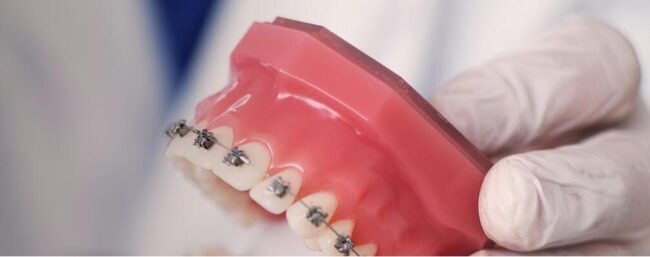Normally, a person’s dentition has a slight overbite. This means that the upper jaw protrudes slightly over the lower jaw. However, there are people for whom this is more pronounced. In certain cases it is then necessary to treat the overbite.
- A person has an overbite if their upper jaw protrudes more than two millimeters above the lower jaw.
- A stronger overbite can cause problems speaking and chewing, among other things, but it can also increase the risk of tooth decay.
- In children, the orthodontist treats the misalignment with braces, whereas in adults an operation is often necessary.
- While the statutory health insurance completely covers the treatment costs for children with a pronounced deformity, it only bears the costs for adults in exceptional cases.
What is an overbite?
In normal, healthy teeth, the upper jaw protrudes about two millimeters. The specification refers to the horizontal distance between the edges of the upper and lower incisors when the mouth is closed. In this case, the upper incisors cover the lower incisors by one to two millimeters. Dentists and orthodontists speak of a severe overbite (scientifically: prognathic) if the upper teeth protrude more than three millimeters from the lower jaw.
- Abbreviationfinder: Find definitions of English word – Association and its abbreviations V.
An enlarged overbite can have different causes . It is formed either by a misalignment of the jaw or by tilted teeth. In most patients, a combination of the two factors is responsible for the overbite. This can be hereditary, but it can also result from unfavorable habits in early childhood. A typical example of this is thumb sucking.
The consequences of an overbite
A severe overbite can cause various problems that should not be underestimated. The misaligned teeth can, for example, have the following effects:
- Difficulty speaking and chewing, especially with your front teeth
- Increased risk of injury to the upper incisors in an accident
- Higher risk of caries attack of the front teeth (due to a lack of saliva flow)
- Upper respiratory tract infection from mouth breathing
- Visible impairment of the facial profile (strongly curved upper lip or “receding chin”)
- Muscle tension and temporomandibular joint pain
How can an overbite be treated?
Which form of therapy the attending physician decides essentially depends on the age of the patient. If a set of teeth shows an overbite in childhood, it makes sense to start treatment early.
The overbite treatment in children
Before puberty, an overbite can in most cases be corrected with conventional braces. This type of treatment aims either to curb the growth of the upper jaw or to encourage that of the lower jaw. To make sure there is enough space, the doctor may remove the small molars.
The overbite treatment in adults
In adult patients, the growth of the jaw is already complete, so that the dentist or orthodontist has to work with other methods. Therefore, the treatment is a bit more complex. If the overbite is not too pronounced, transparent aligners are often used. Fixed braces are sometimes used for more serious misalignments. In many cases, the attending physician also combines orthodontic treatment with surgical intervention.
What does the health insurance company pay?
In the case of children and adolescents, there is a chance that health insurance will cover all of the costs for treatment. The so-called orthodontic indication groups (KIG), which distinguish between five degrees of severity, are used to assess the need for treatment. Costs will be covered if there is a pronounced misalignment of teeth (KIG 3). This is true if the overbite is at least six millimeters. But here too, co-payments are often required. The cash register only pays for the cheapest material that is suitable for the medical purpose. In addition, treatment must begin before the age of 18.
However, there is an obligation for those with statutory health insurance to take over 20 percent of the expenses themselves. After the successful completion of the treatment, the insurance will pay the money back. If several children are being treated at the same time, the co-payment from the second child is only 10 percent.
The insurance usually only reimburses adults for treatment if it is medically necessary. So it must be a serious jaw abnormality that requires braces as well as surgical intervention. In individual cases, it is even possible to cover the costs in full. Otherwise you have to expect expenses in the high four-digit range.
The advantages of additional dental insurance
High- performance supplementary dental insurance covers up to 100 percent of the costs incurred for orthodontic treatment even in adulthood, depending on the tariff. The insurance package usually includes numerous other services such as dentures, professional teeth cleaning or root canal treatments. To find the best provider, it is advisable to compare different types of supplementary dental insurance.




